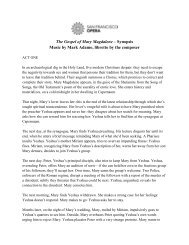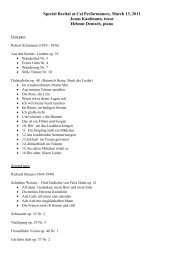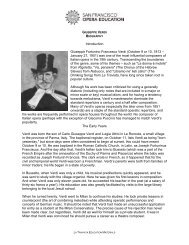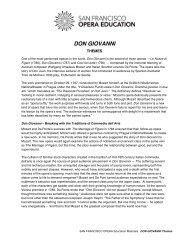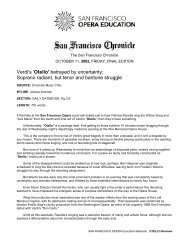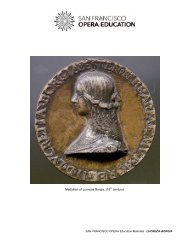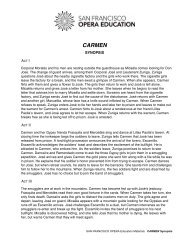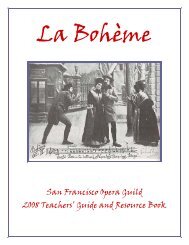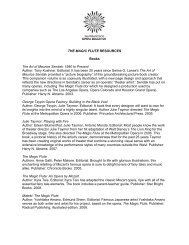The Rake's Progress Teachers Guide - San Francisco Opera
The Rake's Progress Teachers Guide - San Francisco Opera
The Rake's Progress Teachers Guide - San Francisco Opera
Create successful ePaper yourself
Turn your PDF publications into a flip-book with our unique Google optimized e-Paper software.
Bedlam<br />
<strong>The</strong> Bethlem Royal Hospital of London, which has been variously known as St. Mary<br />
Bethlehem, Bethlem Hospital, Bethlehem Hospital and Bedlam, is the world's oldest<br />
psychiatric hospital. <strong>The</strong> word Bedlam has long been used for lunatic asylums in general,<br />
and later for a scene of uproar and confusion.<br />
Bethlem has been a part of London since 1247, first as a priory for the sisters and brethren<br />
of the Order of the Star of Bethlehem. Its first site was in Bishopsgate. In 1330 it became a<br />
hospital, and it admitted the mentally ill in 1403 but there were only nine inmates. Early<br />
sixteenth century maps show Bedlam, next to Bishopsgate, as a courtyard with a few stone<br />
buildings, a church and a garden. Conditions were consistently dreadful, and the care<br />
amounted to little more than restraint.<br />
In 1675 Bedlam moved to new buildings in Moorfields designed by Robert Hooke, outside<br />
the City boundary. In the 18th century people used to go there to see the lunatics.<br />
Eighteenth century Bethlem was most notably portrayed in a scene from William Hogarth's<br />
A <strong>Rake's</strong> <strong>Progress</strong> (1735), the story of a rich merchant's son whose immoral living causes<br />
him to end up in a ward at Bethlem. This reflects the view of the time that madness was a<br />
result of moral weakness, leading to 'moral insanity' to be used as a common diagnosis.<br />
In the early modern period it was widely believed that patients discharged from Bethlem<br />
Hospital were licensed to beg. <strong>The</strong>y were known as Abraham-men or Tom o' Bedlam. <strong>The</strong>y<br />
usually wore a tin plate on their arm as a badge and were also known as Bedlamers,<br />
Bedlamites, or Bedlam Beggars. In William Shakespeare's King Lear, the Earl of<br />
Gloucester's son Edgar takes the role of a Bedlam Beggar in order to remain in England<br />
unnoticed after banishment.<br />
31



